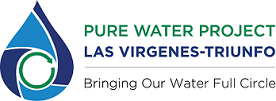Learn More
Brief History of the Pure Water Project: Origins, Goals, and Key Milestones
Origins and Background
The Pure Water Project (PWP) was conceived as a response to several critical challenges facing the Las Virgenes-Triunfo Joint Powers Authority (JPA), which serves communities in western Los Angeles County and eastern Ventura County. The project’s origins trace back to the early 2010s, when the JPA was confronted with increasingly stringent regulatory requirements for discharging treated effluent into Malibu Creek, as well as the need to develop a local, drought-resilient water supply in a region almost entirely dependent on imported water from Northern California via the State Water Project. In 2013, the U.S. Environmental Protection Agency adopted a new Total Maximum Daily Load (TMDL) for Malibu Creek, which would have cost the JPA an estimated $160 million just to maintain the status quo. This regulatory pressure, combined with the region’s vulnerability to drought and lack of local groundwater, prompted the JPA to seek a more sustainable and innovative solution1234.
Project Goals
The Pure Water Project was designed to achieve three primary objectives:
- Comply with more stringent regulatory requirements for discharging to Malibu Creek, thereby protecting local ecosystems.
- Balance the seasonal variation of recycled water demand, addressing the mismatch between supply and non-potable demand, especially in winter months.
- Create a valuable, local, drought-resilient water supply by using advanced water purification technologies to supplement the region’s drinking water, reducing reliance on imported water and enhancing long-term water security
The Pure Water Project Las Virgenes-Triunfo is a pioneering, stakeholder-driven initiative to create a sustainable, local, and drought-resilient water supply for the region. It arose from regulatory, environmental, and supply challenges, and has progressed through a series of technical, environmental, and community milestones. The project is on track to deliver significant water supply, environmental, and economic benefits by 2030



